
Tenant Farming in Oklahoma
Economic Hardship and the Great Depression
The 1920s were a difficult time for farmers in Oklahoma and beyond. Prices were low, forcing farmers to produce more to support their families. This overproduction led to a surplus, causing prices to go even lower. The fields which had once been fertile and reliable had become depleted of their nutrients after generations of over-farming, causing crops to fail. Scientists preached crop diversity, but the average Oklahoma farmer simply couldn’t afford to produce anything besides cotton. They also couldn’t afford the new technologies of the era designed to make farming easier and more efficient, forcing them to work even harder to keep up with the competition.
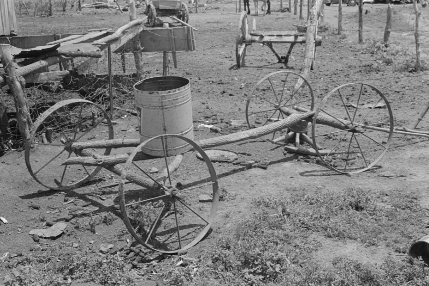
Crude water hauler used by an Oklahoma tenant farmer (image courtesy of the Library of Congress).

Oklahoma tenant farmer looking through the mail (image courtesy of the Library of Congress).
The Great Depression made things even more difficult, as getting the loans farmers had come to rely on became significantly harder. Since cash was in short supply, lenders required collateral such as livestock or machinery, things tenants often lacked and family farmers couldn’t afford to lose. However, many had no choice and were forced to take out these loans, causing them to lose everything when they inevitably defaulted. This resulted in a significant rise in Oklahoma’s tenancy rate, with thousands of families losing the farms they had worked for generations.
Farmer-Labor Reconstruction League
As financial instability returned, so, too, did the labor movement. Some organizations from the past experienced resurgences, as was the case for the Oklahoma Farmers’ Union. Others emerged specifically in response to the conditions and landscape of the time, such as the Farmer-Labor Reconstruction League. Founded in 1921 by a group of Farmers’ Union representatives, Socialists, and labor activists, this organization sought to pool support behind Jack Walton, a Democratic candidate for Oklahoma governor. They hoped that Walton would support their platform in exchange for their combined support, which included calls for state-owned grain elevators and mines, free textbooks, and a home-ownership program for tenants.

Jack Walton, union-supported gubernatorial candidate (13054, Oklahoma Historical Society Photograph Collection, OHS).
Though they succeeded in getting Walton elected, he proved unpopular with the state legislature and was eventually impeached. Still, in his short time in office, he passed several laws benefiting farmers, supporting cooperatives, and establishing state agricultural warehouses, in addition to a campaign seeking to expose and eradicate the Klu Klux Klan in the state. Unfortunately, Walton’s impeachment and the conflict between the different groups it encompassed caused the Farmer-Labor Reconstruction League to crumble.

Front page of Governor Walton’s impeachment trial transcript (image courtesy of Oklahoma Digital Prairie).
Oklahoma Cotton Growers’ Association
While some activists advocated for political solutions to farmers’ financial woes, others focused on establishing cooperatives in their communities. These enterprises provided direct economic support to tenants and farm owners alike, and even helped to raise crop prices and reduce processing rates at noncooperative businesses.
With the success of local cooperatives, calls emerged for larger, state-wide organizations. The Oklahoma Cotton Growers’ Association was established in 1922 and quickly amassed 52,000 members, including many tenants. Cotton growers would pool their cotton to be sold at a set price, thereby reducing competition between individual farmers. The cotton was stored in association-owned warehouses until the market was best for selling, resulting in a higher profit for all members. However, this also meant a delayed profit, which was unattractive to landlords and tenants alike. Many tenants abandoned the association as they believed the benefits they were promised had not appeared. Despite this, the Cotton Growers’ Association would continue serving Oklahoma’s farmers for many years. It would prove to be a robust model of cooperative marketing on a state-wide scale.

Children and adults harvesting cotton in an Oklahoma cotton field (23359.1, Oklahoma Historical Society Friends of the Archive Collection, OHS).
The New Deal
As the Great Depression wore on, farmers continued to suffer. Crops were failing, prices were low, and increasing numbers of families were being forced into tenancy or out of Oklahoma altogether. Finally, in the early 1930s, the government began to address farmers’ troubles on a larger and more substantial scale.
Oklahoma’s state government had made various attempts at helping struggling farmers, such as by introducing regulations on ginning rates and improving rural roads. There was also a short-lived homeownership program, which provided tenants loans to buy their farm. However, demand for these loans was much higher than the money allotted, meaning only a small number of farmers actually received the aid.

Oklahoma tenant mother and children (image courtesy of the Library of Congress).
Despite these gestures, the state government simply didn’t have the funds to support all those in need. The federal government, on the other hand, did. In response to the Great Depression, President Franklin D. Roosevelt championed the New Deal, which included a number of programs to provide financial relief and aid to struggling farmers. However, Oklahoma farmers were unable to reap the benefits of this program for a number of years, as then-Governor William “Alfalfa Bill” Murray resisted the implementation of New Deal policies in the state, believing that relief money should be administered solely by states. It wasn’t till 1935, the end of Murray’s term, that New Deal aid would enter the state. These programs had varying levels of success, with some providing concrete aid and others undermining the very industries they had set out to help.

Franklin D. Roosevelt campaign button featuring New Deal slogan (image courtesy of the Smithsonian National Museum of American History).
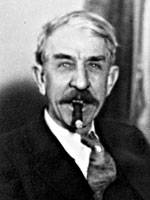
William H. Murray, governor of Oklahoma from 1931 to 1935 (image courtesy of the Oklahoma Digital Prairie).
Agricultural Adjustment Act and the Southern Tenant Farmers’ Union
The Agricultural Adjustment Act (AAA), passed in 1933, was meant to curb agricultural overproduction by paying farmer owners to reduce their farmed acreage. Officials hoped this program would reduce the crop surplus and give over-farmed land a much-needed break. Additionally, they intended for the payments to be split between farm owner and tenant, helping both parties.
Though the AAA did help curb overproduction, it proved disastrous for tenants. Landlords realized that instead of reducing their own production, they could simply evict their tenants, thereby reducing the total farmed acreage and allowing the landlord to pocket the total payment. This caused a huge displacement of tenant families, many of whom were forced out of the state entirely in search of jobs in the West. This mass exodus of Oklahoma migrants is often blamed on the Dust Bowl, but a vast majority of those leaving the state were tenants who had been evicted from their farms more due to AAA and the changing economy than the drought.

A poster intended to quell distrust of the AAA (image courtesy of the National Agricultural Library).

A migrant family preparing to leave Oklahoma (image courtesy of the Library of Congress).
The poor execution of the AAA, as well as the general state of tenancy during the Great Depression, prompted a group of cotton farmers in Arkansas to form the Southern Tenant Farmers’ Union (STFU). This group, founded in 1935, advocated for tenants and sharecroppers and was particularly notable for its lack of segregation, making it the first interracial farm labor organization in the United States. The group quickly gained footing in Oklahoma, in large part due to the tireless work of Odis Sweeden, (Cherokee) who united white, Black, and Native tenant farmers across the state into one unified group.
The STFU directly participated in a state commission on tenancy, which resulted in the Landlord Tenant Relationship Act of 1937. This act sought to improve relations between the two groups, encourage long-term tenancy, and establish Landlord-Tenant Relationship Department. Unfortunately, this act was repealed in 1939, but it still represents one of the most concrete products of farm union advocacy in the state. In the following years, STFU would undergo a series of mergers with other organizations, accompanied by dramatic splits, that rendered it somewhat ineffectual. The Oklahoma branch would fade with the loss of its charismatic leader, Odis Sweeden. However, its legacy of multiracial, unified advocacy remains an inspiration to this day.
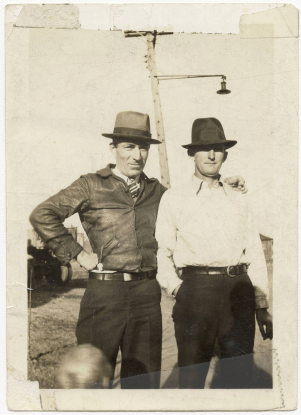
Odis Sweeden (right), charismatic leader of the Oklahoma Tenant Farmers’ Union (image courtesy of University of North Carolina Libraries).
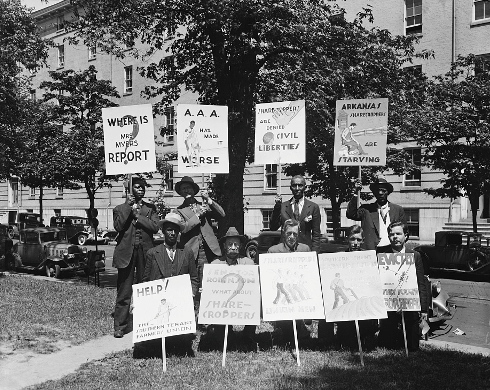
Members of the Southern Tenant Farmers’ Union picketing in Arkansas (Image courtesy of the Library of Congress).
Other New Deal programs implemented in Oklahoma included small loans for livestock and machinery and the establishment of federally-owned cooperative farms. One property, the historic 101 Ranch, was split amongst a number of tenant families who paid rent directly to the government in exchange for a plot. Though the rollout was limited, this demonstrates an attempt by the government to help tenants through unconventional means.
One New Deal program that actually helped tenants on a larger scale was the Farm Security Administration’s homeownership loan program. This program provided tenant families long-term loans to buy their farm, an idea that had been tried before in Oklahoma but failed due to insufficient funds. Created in 1937 and operating until 1944, the Farm Homes Corporation gave out loans resulting in the purchase of 16,000 farms, with nearly 3,000 tenants receiving support in Oklahoma.
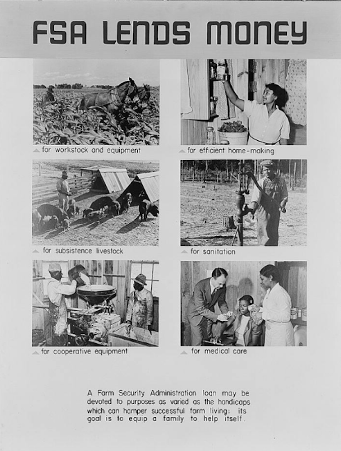
Poster describing various loans available from the Farm Security Administration (image courtesy of the Library of Congress).
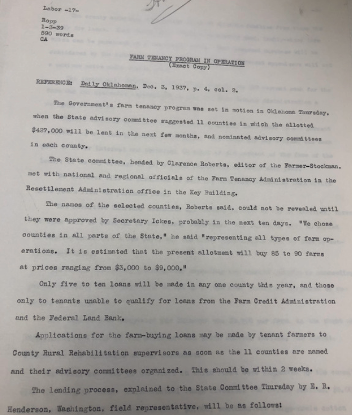
Newspaper excerpt detailing the implementation of the FSA’s tenant homeownership program in Oklahoma (1981.105, Federal Writers’ Project Collection, OHS).
The intended recipients were struggling, though not destitute, farmers who had lived on one farm for an extended period and planned to continue living there for at least five years. This excluded many of Oklahoma’s poorest tenants who weren’t considered established or industrious enough. Despite the definite positive effect on those who received these loans, the implementation was not widespread enough to help the state’s many struggling tenants.
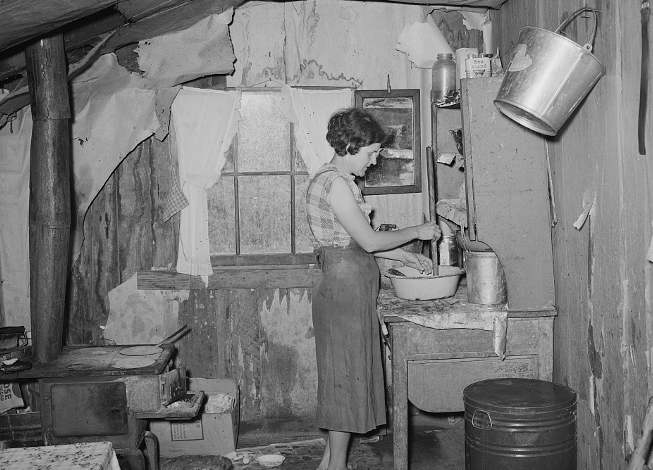
A tenant in her kitchen near Muskogee, Oklahoma (image courtesy of the Library of Congress).

